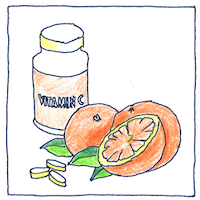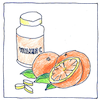Vitamin discoveries
After Frederick Gowland Hopkins asserted that food contained hidden essential nutrients, work began to discover what these “accessory factors” were. Vitamins A and B1, 1913 Separately, Elmer McCollum with Marguerite Davis at Madison and Lafayette Mendel with Thomas Burr Osborne at Yale identified a fat-soluable substance found in butter and cod liver oil that was essential for growth and vision. McCollum called it factor A. The two teams also identified a water-soluable substance found in milk that was later identified as thiamine, vitamin B1. In 1915, McCollum realized this was the substance identified by Christiaan Eijkman that was found in rice hulls, and prevented beriberi. McCollum and Davis started the first colony of rats in the U.S. for studying the effects of dietary nutrients. Supportive of the milk industry in Wisconsin, McCollum advocated lacto vegetarianism. Vitamin D, 1922 Before 1920, Edward Mellanby had found that cod liver oil cured dogs of rickets, and reasoned that vitamin A or something close to it was the reason. Elmer McCollum destroyed the vitamin A in cod liver oil and found that this oil cured dogs of rickets. McCollum called the essential part of the oil vitamin D. In 1925, Adolf Windaus showed that cholesterol on the skin is converted by sunlight to vitamin D3, otherwise known as cholecalciferol. Vitamin E, 1922 Herbert McLean Evans and Katharine Bishop, in feeding experiments with rats, discovered vitamin E, a fat-soluble antioxidant, which is essential for reproduction. Later work showed it to be a group of compounds including tocopherols and tocotrienols. Vitamin B12, 1920-1926 George Whipple discovered that feeding dogs liver helped them recover from anemia the quickest. George Richards Minot and William Murphy found that for dogs iron from the liver was sufficient but that for humans something else was needed and it could be found in the juices from the liver. Eventually, the water-soluble essence was extracted from bacterial broths and called vitamin B12. Vitamin K, 1929 Henrik Dam found that chickens fed a diet without fat suffered from hemorrhages and bleeding, and that normal blood coagulation was not restored by reintroducing cholesterol. Henrik Dam called the essential oil Koagulationsvitamin, so it’s called vitamin K. Vitamin C, 1930 Albert Szent-Györgyi got his PhD in 1927 for isolating “hexuronic acid” from adrenal glands. By 1930, he and his research fellow Joseph Svirbely found that this acid was the previously unidentified factor in limes that cured scurvy.
Vitamers
Vitamin A has several forms, reinol, retinal, retinoic acid, alpha-carotene, beta-carotene, gamma-carotene, and xanthophyll beta-cryptoxanthin, all of which contain a retinyl group and are converted to retinol in the body. Vitamin B has eight vitamers numbered 1 to 12, skipping 4, 8, 10, and 11, which I think had been proposed but failed to pass the test, leaving thiamine (B1), riboflavin (B2), niacin (B3), pantothenic acid (B5), pyridoxine (B6), biotin (B7), folic acid (B9), and cyanocobalamin, hydroxocobalamin, methylcobalamin, and adenosylcobalamin (all B12 vitamers) Vitamin C is ascorbic acid, but salts of ascorbic acid are also included, dehydroascorbic acid, calcium ascorbate, sodium ascorbate, and more. Vitamin D includes calcitriol (D1), ergocalciferol (D2), cholecalciferol (D3). Vitamin E is various tocopherols and tocotrienols. Vitamin K includes phylloquinone (K1), menaquinones (K2), menadiones (K3).
Vitamin X
At our holiday party, an inspired coworker used to say, “I need more vitamin S,” S for sugar. We could all use more vitamin H1, for happiness, vitamin P for peace, and vitamin L for love. I’m wondering whether the generosity vitamin G will turn out to be water-soluable or fat-soluable. Will food or sunlight supply our daily requirements of vitamin J for joy, or F for good fortune? Will caffeine turn out to be vitamin C2? Other candidates could be remedies for a lack of compassion, or kindness, or patience, or a cure for cancer. Will something simple prove to compensate for deficiencies of I for imagination? R for reason? vitamin P for poetry? One may have H2 for hope and still look for that elusive vitamin X.




Technically, D is not a vitamin for most mammals because it can be synthesized on the skin when exposed to sunlight; however, we can be generous in our usage.
See also in The book of science:
Readings in wikipedia: